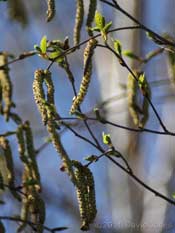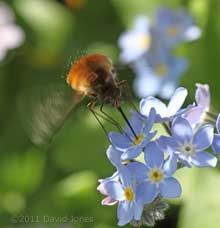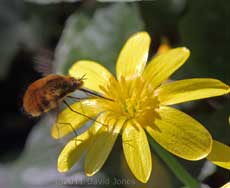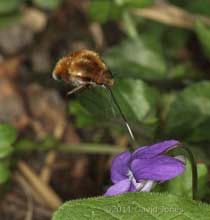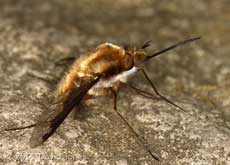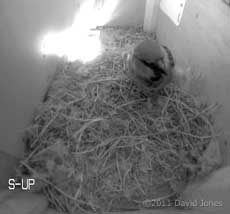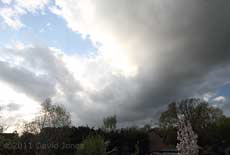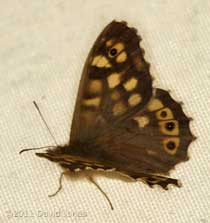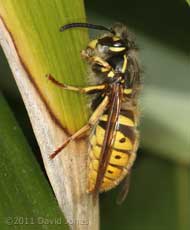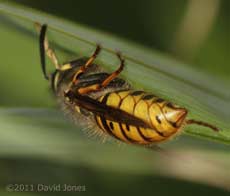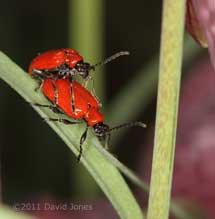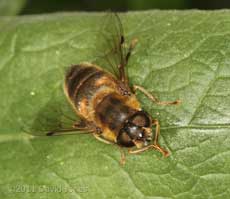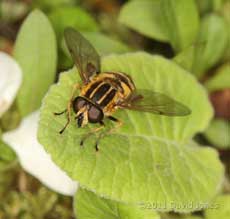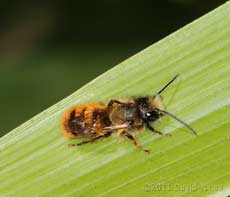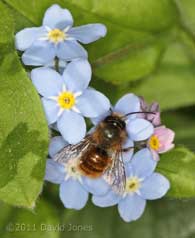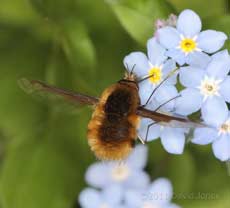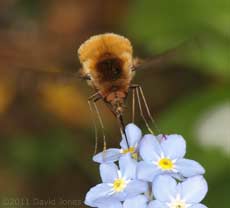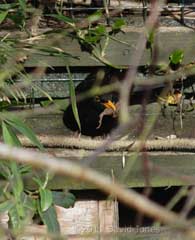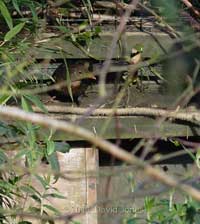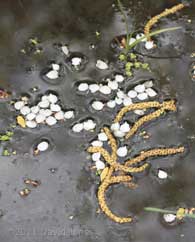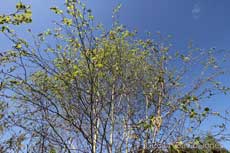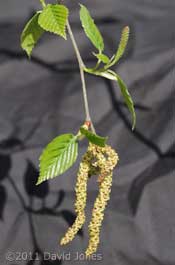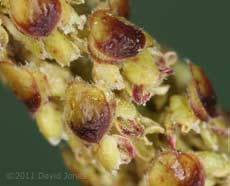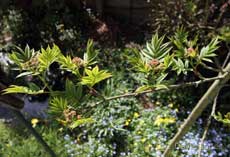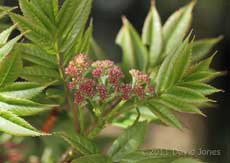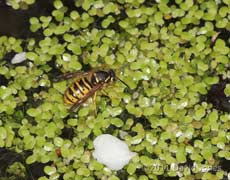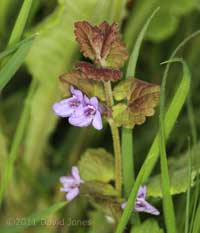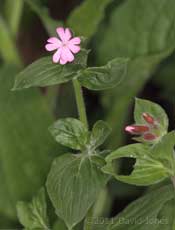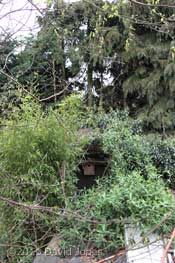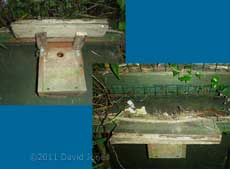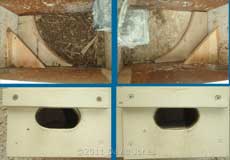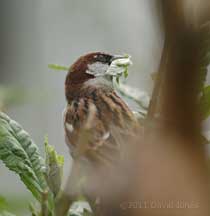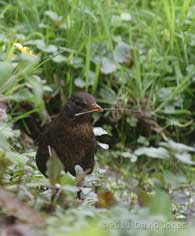Go to the last entry on this page .....Go to previous entry6 April - In contrast to yesterday's greyness today's clouds were almost entirely of the man-made variety (contrails) and the sunshine helped the temperature to rise to at least 21C. For me it was another welcome shorts and sandals day on which I could get on with some more maintenance jobs outside. I didn't get to finally clear up until around sunset when I was treated to a slow, noisy fly past by a pair of Herons, silhouetted against a red western horizon. During the day I saw three butterflies, a Large White, a male Orange-tip, and a large, dark coloured butterfly that I only saw for a moment, and it was too far away to get a good look. There are no tadpole photographs today. I had a good look with a magnifying lens during one of my numerous breaks and I couldn't see any obvious changes. Tomorrow we are in charge of Erin all day, so there will probably be no pictures again. After that visit I intend to transfer some of the tadpoles back to the pond to ease the strain on food resources in the tank. This morning the postman delivered a battery powered air pump which I will be using for a few hours each day from now on. The pump replaces one that I'd been using since 1971 (and which I've managed to mislay this Spring!).
The sunshine really showed up not only the catkins on the Birch this morning, but also touches of green high up in the tree where the leaf buds have just started bursting.
8 April - The unseasonal weather continues with blue skies both yesterday when the temperature reached 22C (equaling a record set in 1974 in the Highlands of Scotland) and today when it only just tipped over 21C - the seasonal average for this part of the country is nearer 12C. It appears that we have air moving up from the Sahara to thank for the warmth along with just a little Saharan dust! Of course there has to be a down side to this taste of summer. March was one of the driest on record, and the newspapers are already discussing the real prospect of hosepipe bans. This early in the year that is not something that we should welcome, even if one long term forecast suggests a wet June/July. A variety of reasons have meant no photographs over the last two day. There has been little to report about the tadpoles, but at least the sunshine has persuaded some frogs to start sunning themselves at the side of the pond, much to the delight of Erin when she was with us yesterday. Today I see that the Bluebells have started opening, although the first buds may have opened yesterday. It is still a case of waiting for developments in the nest boxes. As usual there were visits by individual Sparrows to the Swift and Martin nests. SW-up received more visits than the rest of the nests combined, but all visiting had ceased by 11.25am. The GT box remains unvisited. Even the bumble bees are staying away now. They are still actively investigating nesting places, and one entered House Martin nest 1 at just before 11.30am.
9 April - The sunshine continues, although with some 'real' high level cloud and quite a strong breeze from the east which helped keep the temperature to a maximum of just(!) 20C at lunchtime, dropping to 13C by 6pm.
It's been one of those days when taking things easy wasn't a choice for me. At least unlike yesterday I did take out my camera, this time to record a Bee-fly as it darted about between the flowers below the Rowan. I can't but envy its energy levels as its wings become a blur, even when feeding, here probing the centre of a Forget-me-not with its very long proboscis.
Whilst the Forget-me-nots seemed to be its first choice, it was also happy to spend time at a couple of Lesser Celandines.
With the Bee-fly often hovering before heading towards a flower I tried, but failed to get a clear shot of it in mid-air. On this occasion I can lay some of the blame on the gusty nature of the wind, and the nearest I got was this picture as it was about to feed at a Dog Violet. Unfortunately the wings have all but disappeared!
And finally, after all that effort even the Bee-fly needed to rest its wings for a minute or so, landing on a warm stepping stone, the lack of a sharp shadow emphasizing the hazy nature of the sunshine.
The butterflies seen today include a Brimstone, a Small Tortoiseshell, a Speckled Wood, a Holly Blue and a Large White.
Bird box activity was confined to SW-up and SW-lo today. The visits only ever involved a single bird and there was no occasion when there was a bird in both boxes. It's possible that it was the same male, seen here during one such visit. While in SW-up he has been doing a bit of rearranging of straw and feathers, although I have not seen anything brought in by him.
11 April - After a high of 21C late yesterday afternoon, today has seen the gradual slipping away of the high pressure that brought the plume of warm air up from Africa.
Unfortunately, within the hour that front had passed by with nothing to show for it, and if the forecast is correct we may have to wait a few more days before rain falls on us.
By 7.30pm the sky was clear again! I'm afraid that yesterday became another day off for me, more so than the previous day. I got outside with the camera for a short time around noon, but the pictures remained unprocessed until this afternoon.
During that period in the garden I saw another Holly Blue butterfly and I had my first opportunity to photograph a butterfly when this Speckled Wood landed on the underside of our veranda awning (the picture should really show it upside-down!). I saw the same types of butterflies (and no others) again today.
There has been quite a bit of wasp activity over these last two days, with my best chance for a photograph coming when one lands on a bamboo leaf to sunbathe,
although the wasp will often react to any movement by hiding itself behind the leaf.
During the day I removed twelve Scarlet Lily Beetles (Lilioceris lilii), a serious pest of lilies and fritillaries. They were certainly not wasting time over the business of producing a new generation! Today I found just one example. This Spring the Snake's Head Fritillaries have produced the most flowers yet, and with most of the flowers now fading away I'm hoping for a good harvest of seeds.
Over the last week hoverflies have started to make their appearance in the garden. Various small species have been darting about, but today a couple of the larger hoverflies were well in evidence. Drone-flies seemed to be in the majority,
but there were also the more brightly marked Helophilus pendulus, especially around the big pond.
So far I have ignored the solitary bees that have been active in the garden for several weeks now. At this early stage they prove very difficult to get even moderately close to, even if I move slowly and take care to avoid getting between them and the sun. Like the wasps they often use a bamboo leaf as a 'sun bed', and just once today I was able to grab a picture before the bee flew away. The pristine state of this bee, with no sign of pollen on it suggests that it has only just emerged.
The same problem occurs when they are visiting flowers, and my only success today came as I followed this individual around the cluster of Forget-me-nots under Rowan. To give an idea of scale, the fully opened flowers measure about 10mm across.
I only saw one Bee-fly today and it didn't spend much time here, so I didn't get to attempt any in-flight shots. However, forgive me if I bore you with a couple more shots of it feeding. This time, looking straight down on it meant that the wings show up, despite their constant high speed motion. The insect's long hair make it look much bigger than it actually is.
And this second shot gives another head-on view as its proboscis probes the centre of the flower.
I haven't forgotten the tadpoles, it's just that there has been virtually no visible change in their appearance, apart for a small increase in size. I'm supplementing the duckweed and natural algae in the tank with some lettuce than has been steamed along with the vegetables for one of our meals. It is going down well with the tadpoles and the first pieces that I put in the tank have been reduced to skeletons. We continue to wait for progress in the nest boxes. SW-up continues to be the most promising, although if Sparrows do nest in there they face inevitable eviction should the Swifts return. Activity still involves just a male Sparrow going into both that box and the one below it. For the first time in a while both SW-le and SW-ri were visited by a Starling which still manages to squeeze in through the restricted entrance opening. If it happens again I will have to block both nests for a couple of weeks, until closer to the arrival time of the Swifts. The Great Tit box had two visitors today, a wasp this morning and a bumblebee at the end of the afternoon. If the box isn't going to be used for nesting, and that looking unlikely now, I'm toying with using one of the cameras to monitor the hidden corner of the garden (used as a store for timber and some old surf canoes that I should really get rid of) when there is fox activity. Sometime this week I will to sort out suitable lighting, and as soon as that's arranged I'll set up a camera into place in there. There was a possible tragedy beyond the end of the garden this evening. The frantic panic calls of the Blackbirds from the conifers heralded a raid by at least one Magpie. The interaction between the birds continued for some time but I guess that I will have to wait until the morning to find out whether or not their nest was found. If their clutch was lost to the Magpie I have no doubt that we will see the Blackbird female hard at work nest building again.
12 April - On a sunny, cloudless morning (with no rain overnight) the temperature outside is just over 6C and my fears from last night have been confirmed.
In this picture you can just see the box entrance, partly hidden in the bottom-left corner. Behind the Blackbird there is a wire mesh and in front of him a length of rose stem bristling with thorns (anti-cat measures). He was there for the best part of two minutes before he left,
to allow his partner to inspect the site. Three quarters of an hour later and there is no sign of either returning, but it does mean that they are having to start nesting all over again. I saw the female collecting for the previous nest on 20 March. Their eggs have an incubation period of about 13 days, after up to five days taken over egg laying. On that basis I suspect that when the nest was raided they would have been feeding 3-5 day old chicks.
In the meantime, between 7.30 - 8.30am the male Sparrow was very active in SW-up, dividing his time between bringing in short lengths of straw, arranging it around the possible nest cup and looking out of the entrance. As usual, this activity had finished by mid-morning with no sign of a female joining him in the box. Also, there were no further visits to the nest box roof by the Blackbirds, so the female has probably rejected the idea of building her nest on a rather steep slope!
The snow came courtesy of my neighbour's pear tree blossoms as they shed their petals, and the hail was the male catkins from the higher reaches of our Birch tree. Here are some of the petals an catkins that landed on the shallow end of the big pond. You may also make out that the water has an oily film on it. This is due to the numerous birds that are using the pond as their preferred bathing place.
As the catkins fall, the Birch is becoming quite green now as more and more leaves open up.
And the greening is now spreading to the lower branches. High up in the tree it is only the male catkins, drooping from the apical buds of branches that can be seen from the ground. However, on the lower branches it is possible to see not only those but also the smaller, upright female catkins that form from lateral buds.
Looking closely at the male catkins it is possible to make out the yellow coloured pollen than can sometimes be seen to blow away as a yellow cloud when the wind blows at the right time.
Waiting to receive any pollen that come their way are the pink coloured anthers of the female catkins.
We planted our Rowan on 1 April 2005 and while we have had a few clusters of flowers on it over the last few years, it looks as if we will have a much better display in 2011, if this one branch is anything to go by.
The flowers aren't ready to open, however, last year both the Rowan and the Birch were about two weeks later, and the Rowan flower buds were less well developed than this on 1 May.
I was up a step ladder not only to take the picture but also to remove the apples that I hung on both the Rowan and the Birch ready for the Redwings and Fieldfares which didn't materialize this Spring. The apples' only customers were the Blue Tits and, dare I say, they only pecked at them, leaving most untouched! Down at ground level again, I actually did a bit of conventional gardening this afternoon, repotting some plants - more precisely two Silver Birch, one Hawthorn and one Rowan tree which I have been growing from seedlings. All four native trees are now just over a metre tall and needed bigger pots. Eventually all four trees will be passed on to suitable recipients. When my grandchildren start school, perhaps one or more of the trees will end up there with them...
This is a sight that will be repeated numerous times every (fine) day over the next few months as wasps collect water from our pond to use in the making of the paper needed to build their nests. As yet I haven't seen any wasps scraping wood in the garden to gather the pulp they also need to create that paper.
This evening I have just read that the first Common Swifts have been seen in the UK. If this is the case then I shall have to spend a bit more of my time outside looking up, and the male Sparrow had better get himself an alternative nest site.
13 April - A morning of sunny spells and dark clouds allowed the temperature to rise to 12C by noon, pleasant enough for my grand-children to play in our sand box, but then the cloud thickened and brought a bit of dampness in the late afternoon. However, it didn't last and the ground is dry at dusk with the temperature down to 9C at 8pm. We even lit our log fire this evening!
Just two photographs for the diary today. The first should have been included yesterday and shows the first Ground Ivy flowers spotted here this Spring.
And today we have the first Red Campion to come into flower - the first of very many - eleven days earlier than last year's appearance.
Nest box activity in the Swift boxes was confined to just SW-up this morning and continues to involve just the male. Once again there was a Starling visitor(s) in Sw-le and SW-ri at around 7.30am, so tomorrow morning I shall be plugging those entrances for the next week or so at least. It appears that while there was no activity, neither in nor on the roof of the Great Tit box during the morning and afternoon, at around 6.30pm there was a lot of noise and I saw a blackbird leaving the roof. I couldn't tell which one it was, but I'll be watching and listening again tomorrow as I've seen no sign of the female collecting wet materials from around our ponds today.
14 April - At 8am it is 9C and overcast outside. The ground remains dry and I'm listening to the sounds of a Blackbird at least thinking about building its nest on the roof of the Great Tit nest box! In fact, through the telephoto lens that is semi permanently set up by my dining room window I can see that the female has already delivered pieces of our Birch tree bark, and I've just seen her arrive with some bits of straw. This leaves me wondering how/if I'm going to be able to reposition one of my cctv cameras from inside the nest box tower....
This is the GT nest box as seen from the roof of my work shed. To the left (south) the box is shaded by bamboo plants. Above and to the right it is protected by wire grid panels onto which I have encouraged honeysuckle and Ivy to grow, and the roof of the bird box tower is covered with thorny cuttings from various plants. These precautions mean that the nest site should at least be safe from cats. The nest that was raided by the Magpie(s) was situated high in the conifers seen immediately behind the nest box.
As I write this in the late afternoon I have a camera set up on the shed roof, and a wireless remote switch by my side to take a photograph should the microphone inside the box 'announce' a Blackbird's arrival. - The female didn't return so I'll try again tomorrow.
My concern over the slope and narrowness of the box roof prompted me to raid the log store for some scraps to make a horizontal extension for it, and this was put up as darkness fell. Along the front edge of the roof were a row of long, thin nails with their heads nipped off (anti-cat!), and once the extension was in place I removed the nails that were adjacent to it.
It will be interesting to see how the Blackbirds react tomorrow morning.
While we were having breakfast this morning there was another Starling visit to SW-ri, so afterwards it was a case of working clothes on and ladder out. However, I'm reluctant to actually block the entrances. My fear is that if I do that it is possible that when the Swifts do return I may not 'open' the entrances in time. So, after an inspection I decided on a modification which I hope will finally discourage the Starling.
There was already a triangular piece above each entrance to restrict headroom. However, with the bottom edge of the entrance some 2cm above the floor of the box that triangle was of limited use. To correct this I've now fixed some 2cm thick plywood to the floor. I've also removed the straw ring that I had installed in SW-ri, hoping to make the box less attractive to the Starling (the Swifts that moved into SW-le preferred its bare floor to the left-over nest that was in SW-ri. It may be that I will also need to replace the triangle of wood with a larger piece - if the Starling gets in again tomorrow then that will be my next task.
15 April - Another dry grey day, until just before sunset when the cloud started to break up, although not soon enough for us to enjoy any evening sunshine. The temperature reached 15C in the afternoon. It has been a very quiet day in the Swift boxes, with just a few Sparrow visits to SW-up and SW-lo, and no visits to SW-le and SW-ri - the Starling(s) not even attempting to get in today. In the meantime the Sparrows in the 'proper' sparrow boxes are now getting on with nest building/renovation, and today I've seen them going into six of the eight boxes that we have in place. By the end of the season I would expect that all of those boxes will have had occupants.
Our Buddleia is always one of their main sources for green nesting materials, and it was pecked at numerous times today.
There's great news from above the Great Tit box. For much of the day the radio mike picked up just the general sounds of bird song around the garden, but pictures I took from the house showed that bits of straw had been moved indicating that there had been at least one visit to the box.
At lunchtime I saw the male Blackbird pay a visit, but there was no sign of the female until she headed for the big pond at around 3.15pm when she picked up this single twig. However, instead of collecting more, she dropped it and went on to indulge herself with a long bathing session followed by a feed, probably tadpoles (judging by where she was standing). It was only then that she headed up to the GT box and made (as far as I can tell) her first visit of the day.
Over the next four hours she returned three more times, and then between 7 - 8pm she visited seven times, with the final sounds being heard just after 8pm. While I'm used to seeing all the box nesters performing shuffles in the early stages of nesting as they arrange the straw to form a circle around the future nest cup, this is the first time I've seen (and heard) a Blackbird do the same. There was no hope of capturing any images of it happening this evening. This evening I'm going to look at possible cctv camera/lens combinations that I could use to monitor the nest from the roof of my workshop shed - it should be possible to get images, at least during daylight hours.
Click on images to see larger version
|
|
